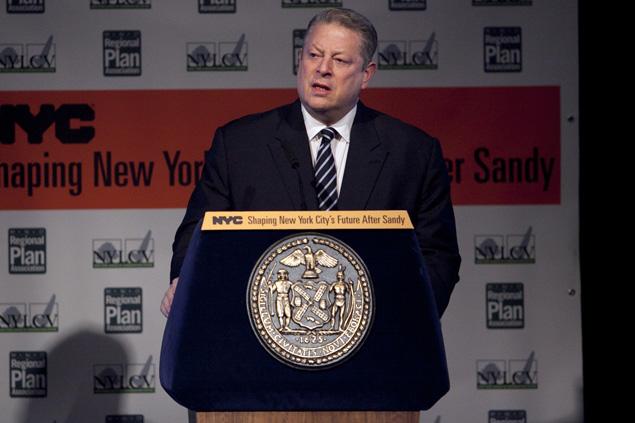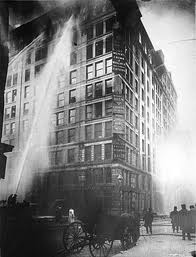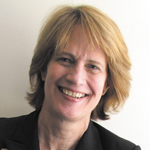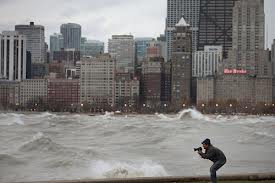By admin on December 6, 2012
Mayor Michael Bloomberg provided his inspiring vision of New York City in the wake of Hurricane Sandy this morning at the Downtown Marriott at a breakfast titled, “Shaping New York City’s Future After Sandy.” The surprise guest at the event was Vice President Al Gore, who addressed Climate Change issues in the wake of Hurricane Sandy and introduced the mayor.
Gore advised the overflow breakfast crowd that New York City was fortunate to have Mayor Bloomberg heading and driving the re-building effort. In his mind, and in the minds of leading Climate Change scientists, such as Dr. James E. Hanson and Dr. Kevin Trenberth, the ferocity of Hurricane Sandy was clearly attributable to global warming.
Although Hurricane Sandy was a Category I storm, it had the lowest barometric pressure of any storm in history north of the Mason Dixon Line. Gore asked rhetorically, “What will it take for a national government to take action?” Using a computer analogy, Gore argued that our democracy had been “hacked.” The American people, he said, cannot afford four more years of governmental dysfunction.
Addressing New York’s recovery from Hurricane Sandy, Bloomberg thanked New York City’s policemen, firemen, sanitation workers and volunteers. He congratulated the Marriott Hotel, where the event was held, for reopening so quickly in a flood ravaged neighborhood. He said that he could see the waterline from the flood still visible in the Hotel lobby.
Although many buildings in Lower Manhattan still have no electricity and remain unoccupied, he applauded the City Sanitation Department for removing over 350,000 tons of debris from Lower Manhattan, which has at least restored the appearance of business as usual to the area, even if buildings there remained uninhabitable and unoccupied..
Bloomberg stated that New York had never before been hit with a storm with Sandy’s ferocity. Water levels at the Battery reached 14 feet in elevation, an event that FEMA previously predicted had a less than 1% probability of occurring. He urged the audience not to leave Climate Change to future generations to address. He cautioned that a child born today would see a two and a half foot rise in sea level by his 40th birthday.
Bloomberg urged New Yorkers to take a leadership role on the issue of Climate Change. If New York City takes action, the rest of the country will follow. In discussing New York’s leadership role, Bloomberg said that when California banned smoking in public places, no one took notice. But when New York City banned smoking in public places, the rest of the world followed. Quoting former Mayor Ed Koch, “New York City is where the future comes to audition.”
Cities around the world are not waiting for national governments to act on Climate Change. Mayors around the world formed the C40 Cities Climate Leadership Group in 2005, a network of the world’s largest cities committed to addressing Climate Change. Bloomberg is the current C40 Chair.
Bloomberg stressed that the next climate-related event to strike New York may not come in a manner planned for or predicted. However, referencing past catastrophic events to strike New York over the past two hundred years, he predicted that New Yorkers would continue to thrive through adaptation, and placing “politics as usual” aside, to come up with the best solution for the City. In particular, he discussed the Great Fire of 1835, which burned most of Lower Manhattan to the ground. As a result of that experience, the City reformed the Fire Department and built a municipal water supply at the Croton Dam upstate to ensure that water would be available to fight future fires. The Great Blizzard of 1888 resulted in the planning for a subway system; the Triangle Shirtwaist Factory Fire of 1911 resulted in the promulgation of a new fire code, child labor laws and workplace safety rules; and 9/11 resulted in the City establishing a sophisticated security apparatus.
particular, he discussed the Great Fire of 1835, which burned most of Lower Manhattan to the ground. As a result of that experience, the City reformed the Fire Department and built a municipal water supply at the Croton Dam upstate to ensure that water would be available to fight future fires. The Great Blizzard of 1888 resulted in the planning for a subway system; the Triangle Shirtwaist Factory Fire of 1911 resulted in the promulgation of a new fire code, child labor laws and workplace safety rules; and 9/11 resulted in the City establishing a sophisticated security apparatus.
Looking to the future, Bloomberg advised that he had formed a “After Action Review” to critique the response to Hurricane Sandy. He expected to receive the report by the end of February 2013, and to make it public thereafter. He also informed attendees that he had retained Seth Pinsky , President of the NYC Economic Development Corporation, to develop New York’s action plans for the future under the guidance Deputy Mayors Cass Holloway and Bob Steel. Pinsky’s report will discuss comprehensive planning and building proposals for each community that was stricken by Hurricane Sandy, and examine, among other things, schools, businesses, homes and hospitals in those areas.
Bloomberg stressed that the City needs to adapt to Climate Change risk and the attendant rising sea levels and increasing storm intensity. He said that he planned to propose new zoning regulations that will permit homeowners and businesses to elevate boilers above ground. He will modify zoning rules to permit residents to have rebuild their homes to build higher without regard to existing height restrictions. He will work with FEMA to revise the 1983 FEMA Flood Maps so that appropriate structural requirements in those vulnerable zones may be addressed.
Bloomberg stressed that he has no intention of abandoning the waterfront, but recognized that it is not possible to merely rebuild and hope for the best. The rebuilding has to be performed smarter and more sustainably. Bloomberg is examining Staten Island’s Green Belt and restoring wetlands in and around Manhattan that will provide protection to the City.
Bloomberg advised that he recently met with the CEO of Verizon to discuss plans for rebuilding its network in Lower Manhattan. Some 95% of Verizon’s copper network was taken out of commission in Lower Manhattan as a result of the hurricane. Because wireless networks are increasingly important, Verizon must rebuild with fiber, rather than copper. In addition, the Mayor said that it was unacceptable that cell towers had only eight hours of battery backup due to the City’s heavy reliance on cell service. Those towers must provide power for much longer periods. In addition, he announced that Con Edison would make a $250,000,000 investment to "harden" its electrical, gas, and steam systems.
 The morning’s event was co-sponsored by The New York League of Conservation Voters (“NYLCV”) and the Regional Plan Association.Marcia Bystryn, the President of NYLCV, opened the meeting by reminding the audience that PlaNYC was announced by the Mayor almost six years ago to the day. PlaNYC was created as a bold agenda to meet the challenges of a changing climate and challenged New Yorkers to ask each other how they wanted their city to look and feel in 2030. Bystryn stated that, “We can build on the principles of PlaNYC in the wake of Hurricane Sandy, but with a renewed sense of urgency and creativity.”
The morning’s event was co-sponsored by The New York League of Conservation Voters (“NYLCV”) and the Regional Plan Association.Marcia Bystryn, the President of NYLCV, opened the meeting by reminding the audience that PlaNYC was announced by the Mayor almost six years ago to the day. PlaNYC was created as a bold agenda to meet the challenges of a changing climate and challenged New Yorkers to ask each other how they wanted their city to look and feel in 2030. Bystryn stated that, “We can build on the principles of PlaNYC in the wake of Hurricane Sandy, but with a renewed sense of urgency and creativity.”
Robert D. Yaro, the President of the Regional Planning Association, who spoke next, urged that new approaches to how we build our homes, roads and infrastructure had to be adopted to make them more resilient against storms like Hurricane Sandy.
 Michael Brune, the Executive Director of the Sierra Club, pointed out that in the Presidential Campaign, it was not one of the candidates running for office who made Climate Change an issue; rather; it was Mayor Bloomberg.
Michael Brune, the Executive Director of the Sierra Club, pointed out that in the Presidential Campaign, it was not one of the candidates running for office who made Climate Change an issue; rather; it was Mayor Bloomberg.
According to Brune, the United States has retired 125 coal plants during the last several years. As a result, the percentage of the nation’s power needs from coal plants has sprung from 52% to 32% during this period, and largely explains why the United States has reduced greenhouse gas emissions more than any other country in the world. Brune argued that, although an international treaty on greenhouse gas reduction might be necessary, a treaty alone would not resolve the issue. Rather Climate Change needs to be fought city by city and plan by plan.
 Courts have long struggled with hybrid fact scenarios that involve both a product and a service. When a corporate defendant is sued for personal injury, is it more advantageous for the defendant to be characterized as a service provider rather than a product manufacturer? The knee jerk reaction of some defense lawyers is that they would prefer their client to be cast as service providers. After all, who wants their client to be subjected to a strict liability product claim if it could be avoided, right? Not so fast. The answer to this question may be more complicated that it appears at first blush.
Courts have long struggled with hybrid fact scenarios that involve both a product and a service. When a corporate defendant is sued for personal injury, is it more advantageous for the defendant to be characterized as a service provider rather than a product manufacturer? The knee jerk reaction of some defense lawyers is that they would prefer their client to be cast as service providers. After all, who wants their client to be subjected to a strict liability product claim if it could be avoided, right? Not so fast. The answer to this question may be more complicated that it appears at first blush.
 In product liability litigation, a single tactical advantage may determine whether the case is won or lost. Often, being able to anticipate an issue before it arises and addressing it in the Case Management Order may be critical. This is particularly the case in pharmaceutical mass tort litigation.
In product liability litigation, a single tactical advantage may determine whether the case is won or lost. Often, being able to anticipate an issue before it arises and addressing it in the Case Management Order may be critical. This is particularly the case in pharmaceutical mass tort litigation.
 Having now completed discovery, you have provided the client with a thorough assessment of its potential liability exposure in the case. You are set for trial.
Having now completed discovery, you have provided the client with a thorough assessment of its potential liability exposure in the case. You are set for trial.
 particular, he discussed the
particular, he discussed the  The morning’s event was co-sponsored by The New York League of Conservation Voters (“NYLCV”) and the Regional Plan Association.
The morning’s event was co-sponsored by The New York League of Conservation Voters (“NYLCV”) and the Regional Plan Association. Michael Brune, the Executive Director of the Sierra Club, pointed out that in the Presidential Campaign, it was not one of the candidates running for office who made Climate Change an issue; rather; it was Mayor Bloomberg.
Michael Brune, the Executive Director of the Sierra Club, pointed out that in the Presidential Campaign, it was not one of the candidates running for office who made Climate Change an issue; rather; it was Mayor Bloomberg. The Second Circuit yesterday rendered its much-anticipated decision in
The Second Circuit yesterday rendered its much-anticipated decision in  Given the importance of the case, it is likely that rehearing en banc will be sought and, perhaps, a petition filed by the government with the Supreme Court. However, it also may be the government’s strategy to follow a policy of non-acquiescence and litigate the point in other circuits, hoping to create a split. In any event, this is a case that pharmaceutical and medical device companies need to watch closely.
Given the importance of the case, it is likely that rehearing en banc will be sought and, perhaps, a petition filed by the government with the Supreme Court. However, it also may be the government’s strategy to follow a policy of non-acquiescence and litigate the point in other circuits, hoping to create a split. In any event, this is a case that pharmaceutical and medical device companies need to watch closely.  There is a significant risk that there will be a resurgence of mold claims and mold litigation in the wake of Hurricane Sandy. Sandy left behind thousands of homes and offices in New York and New Jersey with flood-soaked flooring and sheet rock and water-damaged carpeting and personal belongings, which are all potential sources of mold if not removed and replaced. In addition to potential mold exposure to property owners and lessees, there is the potential occupational risk to the thousands of workers in the construction trades who are working to repair damaged homes and offices.
There is a significant risk that there will be a resurgence of mold claims and mold litigation in the wake of Hurricane Sandy. Sandy left behind thousands of homes and offices in New York and New Jersey with flood-soaked flooring and sheet rock and water-damaged carpeting and personal belongings, which are all potential sources of mold if not removed and replaced. In addition to potential mold exposure to property owners and lessees, there is the potential occupational risk to the thousands of workers in the construction trades who are working to repair damaged homes and offices. in writing what responsibility, if any, the building contractor has for addressing mold conditions, particularly those conditions that may be adjacent to area of new construction.
in writing what responsibility, if any, the building contractor has for addressing mold conditions, particularly those conditions that may be adjacent to area of new construction.

 In
In 

 In many jurisdictions, a product liability plaintiff is not permitted to testify concerning what he or she would have done had there been an adequate warning on a product; such testimony is considered both self-serving and speculative. In the absence of such testimony, some states have adopted the Heeding Presumption.
In many jurisdictions, a product liability plaintiff is not permitted to testify concerning what he or she would have done had there been an adequate warning on a product; such testimony is considered both self-serving and speculative. In the absence of such testimony, some states have adopted the Heeding Presumption.
